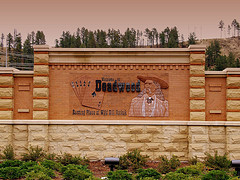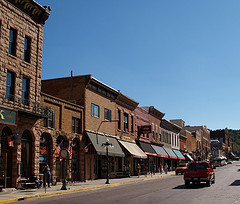Is Deadwood gambling with history? (Part I)
07 May 2014 – Eric Zimmer

The close relationship between Deadwood’s gaming and a specific version of its history is clearly represented upon entering the town’s limits.
Photo credit: Patti McNeal
Twenty-five years ago, the state of South Dakota legalized commercial gaming within the boundaries of Deadwood, a small mining town nestled high in the Black Hills. Ever since, everyone from tourists and gamblers to film crews and rock stars have flooded its streets. The town’s unique history helped transform Deadwood into a hotbed for heritage tourism. As Jay D. Vogt, director of the South Dakota State Historical Society, recently wrote, “the colorful legends of Wild Bill Hickok and Calamity Jane,” two storied characters from the town’s brief flirtation with the “Wild West” of the 1870s, “make Deadwood a nationally recognized destination.” From 2004 to 2006, HBO even aired a popular television show set in (and named after) Deadwood, a portrayal which enhanced the town’s rugged visage and broadcast its regional past to national audiences. But community members and public historians, who have long struggled to make sure that Deadwood’s comfortable, tourist-friendly image includes diverse and critical perspectives on the past, have faced an additional challenge in recent months as at least one casino has destroyed a historic site in the name of expanding its business.
On one hand, Deadwood benefits greatly from this symbiosis of history and gaming. The town struggled economically for decades before the 1980s. Situated just miles from the Homestake Mine, North America’s largest gold mine until its closure in 2002, most Deadwood residents made a living searching for nuggets in the labyrinthine depths of the Black Hills. The town struggled to diversify its economy or to establish long-term growth for most of the twentieth century. Since 1989, however, visitors have buoyed the local economy, helping to create jobs, raise property values, and generate revenue for historic preservation. It may seem only natural that the community, whose most famous resident, Wild Bill, died with aces and spades in his hand, should draw its funding for historic preservation from blackjack and roulette tables.

Old West-style facades and a brick-laid Main Street are a key feature of the heritage tourism industry in downtown Deadwood.
Photo credit: Craig Bennett
Today, some eighty casinos dot the town of only 1,200residents, and historic preservation receives about $7 million annually from the gaming industry. Deadwood uses that money to preserve and maintain its own historic sites, support museums and visitor centers, pay a full professional staff at its historic preservation office, and provide preservation and interpretation grants for projects across the state. Overall, the town has pumped nearly $46.3 million into heritage projects statewide since the 1980s.
Additionally, investments in historic rehabilitation have injected a whopping $329 million into the state economy, while the region’s booming heritage tourism only sweetens this deal. Every year, more than three million visitors stop at Mount Rushmore National Monument (some 50 miles south of Deadwood)—not bad considering that South Dakota itself has less than 900,000 residents—while the state boasts sixteen National Historic Landmarks and some 6,700 listings on the National Register of Historic Places. On top of that, 22 percent of all hotel stays in South Dakota are related to history or heritage tourism. Clearly, Deadwood’s gamble on public history and preservation has paid off.
Yet there is a darker side to this otherwise healthy marriage between past and penny, irking public historians and community members alike: in the last few months, some influential players in Deadwood’s casino industry have skirted preservation laws and, in the process, destroyed a structure listed on both the state and national registers of historic places.
Part 2 follows.
~ Eric Zimmer is a doctoral student in the Department of History at the University of Iowa. He grew up in the Black Hills of South Dakota.




Great article but you have overlooked the archaeological potential of any land area in Deadwood. The City has a horrible record in this area. The Rec Center was the most recent destruction of a historical hospital site. They ruined the site for archaeological analysis by machinery digging and then completed the Rec Center. There needs to be an formal archaeological analysis done on any digging in Deadwood. Jerry L. Bryant is Deadwood resident. He is an accomplished historian and is also a member of the RPA, Registered Professional Archaeologists.